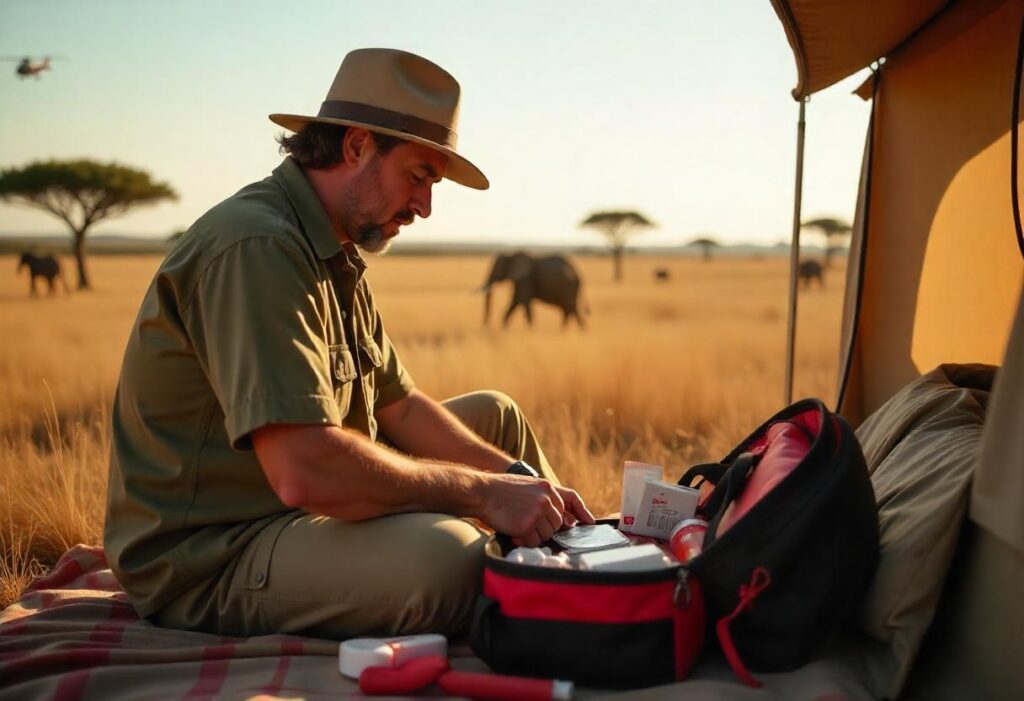Going on safari is an unforgettable experience, but it often takes you far from hospitals, pharmacies, and emergency services. Whether you’re dealing with a minor injury or a serious health scare, being prepared can make all the difference. In this guide, we’ll explore what you need to know to handle medical emergencies while on safari in Africa.
Why preparation matters in remote safari areas
Safari lodges are often located in isolated regions, hours (or even days) away from major medical facilities. That means you’ll need to rely on what’s available on-site or via emergency evacuation. Knowing how to act quickly, what services exist, and how to plan ahead can ensure both your safety and peace of mind.
Air evacuation: when and how it’s used
What is a medical evacuation?
Medical evacuations, often referred to as “medevac,” involve transporting a patient from a remote area to a hospital via helicopter or small aircraft. This is essential for severe injuries or life-threatening illnesses when time is critical.
How evacuation services work on safari
- Most reputable safari operators partner with air ambulance providers
- Evacuation flights usually go to the nearest major hospital in cities like Nairobi, Johannesburg, or Cape Town
- Services may require pre-registration before your trip
Estimated response times
Depending on your location and weather conditions, evacuation can take anywhere from 2 to 12 hours. Having a clear plan ahead of time helps reduce delays.
Medical support at safari lodges
On-site first aid and trained staff
Most lodges are equipped with basic first aid kits and have staff trained in emergency response. However, they are not substitutes for clinics or hospitals.
Communication tools
Reliable lodges will have radios, satellite phones, or cellular signal boosters to call for help when needed.
When to rely on the lodge vs. when to call for evacuation
Use on-site support for:
- Minor cuts, bites, burns, and dehydration Call for evacuation in cases of:
- Snake bites
- Severe allergic reactions
- Chest pain
- Broken bones
The importance of travel insurance with medical rescue
What to look for in a safari travel insurance plan
- Coverage for emergency medical expenses and evacuation
- 24/7 assistance hotline
- Pre-authorization requirements clearly outlined
Why many policies exclude high-risk activities
Not all insurance plans automatically include safaris or bush activities. Double-check the fine print and consider plans that explicitly mention coverage for remote regions and wildlife travel.
Your medical information: what to bring and why it matters
Your personal medical profile
Prepare a one-page medical summary that includes:
- Allergies
- Medications (with dosages)
- Blood type
- Chronic conditions
- Emergency contact details
Format and language tips
- Print a copy and carry it with your passport
- Save a digital version on your phone
- Translate into English if needed (especially for non-native speakers)
First aid essentials every safari traveler should pack
Even though lodges have basic supplies, packing a small personal first aid kit is wise. Essentials include:
- Painkillers (e.g., ibuprofen, paracetamol)
- Antiseptic wipes
- Blister pads and bandages
- Electrolyte tablets
- Antihistamines
- Anti-diarrheal tablets
- Prescription medications
Conclusion: stay safe with smart planning
Medical emergencies on safari are rare, but being unprepared can turn a minor issue into a serious crisis. With the right insurance, information, and gear, you can explore Africa’s wilderness with confidence. Remember: preparation isn’t paranoia—it’s peace of mind.
FAQs
If you feel unwell while on safari, inform your guide or lodge staff immediately. Most quality lodges have first-aid kits and protocols in place, and can contact emergency evacuation services if needed.
Yes, many safari operators partner with medical evacuation services that provide airlifts to the nearest hospital. Having insurance that covers evacuation is crucial for safaris in remote regions.
You should choose travel insurance that includes medical coverage, emergency evacuation, and repatriation. Ensure it’s valid in all countries you’ll be visiting.
Most safari lodges are equipped with trained staff for basic first aid. Some luxury camps may have on-call medical professionals or rapid communication systems for emergencies.
Your medical information should include blood type, allergies, medications, pre-existing conditions, emergency contacts, and insurance details. Keep a printed and digital copy with you.
Yes, it’s recommended to pack a compact first-aid kit with essentials like antiseptics, painkillers, antihistamines, blister pads, and any prescription medications you need.






